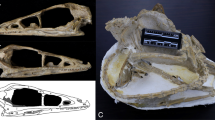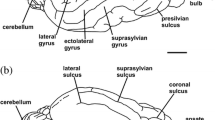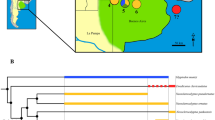Abstract
The internal cranial morphology of the terrestrial sloth Glossotherium robustum is described here based on a neurocranium from the late Pleistocene of the Pampean region of Buenos Aires, northeastern Argentina. The first published data on the morphology of the brain cavity of this species date back to the latest nineteenth century. The novel techniques of CT scanning and digital reconstructions enable non-destructive access to the internal cranial features of both extinct and extant vertebrates, and thus improve our knowledge of anatomical features that had previously remained obscure. Therefore, we performed CT scans on the posterior half of a skull of G. robustum and created digital models of the endocasts and internal structures. The results reveal the morphology of the brain cavity itself, as well as the paranasal sinuses and the trajectory of several cranial nerves and blood vessels. These features have been compared with the two extant folivoran genera, the two-toed sloth Choloepus and the three-toed sloth Bradypus. For many characteristics, especially those related to the paranasal pneumaticity and the brain cavity, a closer similarity between Glossotherium and Choloepus is observed, in accordance with the most widely accepted phylogenetic scenarios. However, other features are only shared by the two extant genera, but are probably related to allometric effects and the convergence that affected the two modern lineages. This study, which represents the first exhaustive analysis of digital endocasts of a fossil sloth, reveals the importance of the application of new methodologies, such as CT scans, for elucidating the evolutionary history of this peculiar mammalian clade.





Similar content being viewed by others
References
Ameghino F (1889) Contribución al conocimiento de los mamíferos fósiles de la República Argentina. Actas Acad Nac Ciencias Córdoba 6:1–1027
Anthony J (1953) Morphologie externe du télencéphale dans le genre Bradypus L. (Edentata). Mammalia 17(3):1–149
Antoine PO, Marivaux L, Croft DA, Billet G, Ganerød M, Jaramillo C, Martin T, Orliac MJ, Tejada J, Altamirano AJ, Duranthon F, Fanjat G, Rousse S, Salas Gismondi R (2012) Middle Eocene rodents from Peruvian Amazonia reveal the pattern and timing of caviomorph origins and biogeography. Proc R Soc B-Biol Sci 279:1319–1326
Antoine PO, Salas-Gismondi R, Pujos F, Ganerød M, Marivaux L (2017) Western Amazonia as a hotspot of mammalian biodiversity throughout the Cenozoic. J Mammal Evol 24(1): 5–17
Bargo MS, De Iuliis G, Vizcaíno SF (2006a) Hypsodonty in Pleistocene ground sloths. Acta Palaeontol Pol 51(1):53–61
Bargo MS, Toledo N, Vizcaíno SF (2006b) Muzzle of South American Pleistocene ground sloths (Xenarthra, Tardigrada). J Morphol 267:248–263
Bargo MS, Vizcaíno SF (2008) Paleobiology of Pleistocene ground sloths (Xenarthra, Tardigrada): biomechanics, morphogeometry and ecomorphology applied to the masticatory apparatus. Ameghiniana 45(1):175–196
Bargo MS, Vizcaíno SF, Archuby FM, Blanco RE (2000) Limb bone proportions, strength and digging in some Lujanian (Late Pleistocene-Early Holocene) mylodontid ground sloths (Mammalia: Xenarthra). J Vertebr Paleontol 20(3):601–610
Barone R, Bortolami R (2004) Anatomie comparée des mammifères domestiques. Tome 6, Neurologie I, Système Nerveux Central. Vigot Frères, Paris
Bergqvist LP, Abrantes EAL, Avilla LDS (2004) The Xenarthra (Mammalia) of São José de Itaboraí Basin (upper Paleocene, Itaboraian), Rio de Janeiro, Brazil. Geodiversitas 26(2):323–337
Bertrand OC, Amador-Mughal F, Silcox MT (2017) Virtual endocast of the early Oligocene Cedromus wilsoni (Cedromurinae) and brain evolution in squirrels. J Anat 230(1):128–151
Billet G, Hautier L, de Thoisy B, Delsuc F (2017) The hidden anatomy of paranasal sinuses reveals biogeographically distinct morphotypes in the nine-banded armadillos (Dasypus novemcinctus). PeerJ Preprints 5:e2923v1 https://doi.org/10.7287/peerj.preprints.2923v1
Blanco RE, Rinderknecht A (2008) Estimation of hearing capabilities of Pleistocene ground sloths (Mammalia, Xenarthra) from middle-ear anatomy. J Vertebr Paleontol 28(1):274–276
Blanco RE, Rinderknecht A (2012) Fossil evidence of frequency range of hearing independent of body size in South American Pleistocene ground sloths (Mammalia, Xenarthra). C R Palevol 11(8):549–554
Blaney SPA (1990) Why paranasal sinuses? J Laryngol Otol 104:690–693
Blanton PL, Biggs NL (1969) Eighteen hundred years of controversy: the paranasal sinuses. Am J Anat 124:135–148
Bocquentin J (1979) Mammifères fossiles du Pléistocène supérieur de Muaco, État de Falcón, Venezuela. Dissertation, Université Pierre et Marie Curie
Boscaini A, Iurino DA, Billet G, Hautier L, Sardella R, Tirao G, Gaudin TJ, Pujos F (2018) Phylogenetic and functional implications of the ear region anatomy of Glossotherium robustum (Xenarthra, Mylodontidae) from the late Pleistocene of Argentina. Sci Nat https://doi.org/10.1007/s00114-018-1548-y
Bugge J (1979) Cephalic arterial pattern in New World edentates and Old World pangolins with special reference to their phylogenetic relationships and taxonomy. Acta Anat 105:37–46
Christiansen P, Fariña RA (2003) Mass estimation of two fossil ground sloths (Mammalia, Xenarthra, Mylodontidae). Senckenb Biol 83(1):95–101
Clemente CD (1985) Gray’s Anatomy. Lea and Febiger, Philadelphia
Constantinescu GM, Schaller O (2012) Illustrated Veterinary Anatomical Nomenclature. Enke Verlag, Stuttgart
Cope ED (1889) The Edentata of North America. Am Nat 23(272):657–664
Cunningham JA, Rahman IA, Lautenschlager S, Rayfield EJ, Donoghue PC (2014) A virtual world of paleontology. Trends Ecol Evol 29(6):347–357
Czerwonogora A, Fariña RA, Tonni EP (2011) Diet and isotopes of late Pleistocene ground sloths: first results for Lestodon and Glossotherium (Xenarthra, Tardigrada). Neues Jahrb Geol Palaontol Abh 262(3):257–266
Dechaseaux C (1958) Encéphales de xénarthres fossiles. In: Piveteau J (ed) Traité de Paléontologie. Masson and Cie, Paris, pp 637–640
Dechaseaux C (1962a) Encéfalos de Notongulados y de Desdentados Xenarthros Fósiles. Ameghiniana 2(11):193–209
Dechaseaux C (1962b) Singularités de l'encéphale de Lestodon, mammifère édenté géant du Plésitocène d'Amérique du Sud. C R Acad Sci 254:1470–1471
Dechaseaux C (1971) Oreomylodon wegneri, édenté gravigrade du Pléistocène de l’Équateur - Crâne et moulage endocrânien. Ann Paleontol 57(2):243–285
De Iuliis G, Cartelle C, McDonald HG, Pujos F (2017) The mylodontine ground sloth Glossotherium tropicorum from the late Pleistocene of Ecuador and Peru. Pap Palaeontol: https://doi.org/10.1002/spp2.1088
Delsuc F, Catzeflis FM, Stanhope MJ, Douzery EJ (2001) The evolution of armadillos, anteaters and sloths depicted by nuclear and mitochondrial phylogenies: implications for the status of the enigmatic fossil Eurotamandua. Proc R Soc B 268(1476):1605–1615
Dozo MT (1987) The endocranial cast of an early Miocene edentate, Hapalops indifferens Ameghino (Mammalia, Edentata, Tardigrada, Megatheriidae). Comparative study with brains of recent sloths. J Hirnforsch 28(4):397–406
Dozo MT (1994) Interpretación del molde endocraneano de Eucholoeops fronto, un Megalonychidae (Mammalia, Xenarthra, Tardigrada) del Mioceno temprano de Patagonia (Argentina). Ameghiniana 31(4):317–329
Dozo MT, Martínez G (2016) First digital cranial endocasts of late Oligocene Notohippidae (Notoungulata): implications for endemic South American ungulates brain evolution. J Mammal Evol 23(1):1–16
Edinger T (1950) Frontal sinus evolution (particularly in the Equidae). Bull Mus Comp Zool Harvard 103:411–496
Elliot-Smith GE (1898) The brain in the Edentata. Trans Linn Soc Lond Ser 2 (Zoology) 7:277–394
Engelmann GF (1985) The phylogeny of the Xenarthra. In: Montgomery GG (ed) The Evolution and Ecology of Armadillos, Sloths and Vermilinguas. Smithsonian Institution Press, Washington, D.C., pp 51–64
Esteban GI (1996) Revisión de los Mylodontinae cuaternarios (Edentata-Tardigrada) de Argentina, Bolivia y Uruguay. Sistemática, filogenia, paleobiología, paleozoogeografía y paleoecología. Dissertation, Universidad Nacional de Tucumán
Evans HE (1993) Miller’s Anatomy of the Dog, 3rd edition. Saunders, Philadelphia
Fariña RA, Vizcaíno SF (2003) Slow moving or browsers? A note on nomenclature. Senckenb Biol 83(1):3–4
Farke AA (2007) Morphology, constraints, and scaling of frontal sinuses in the hartebeest, Alcelaphus buselaphus (Mammalia: Artiodactyla, Bovidae). J Morphol 268(3):243–253
Farke AA (2008) Function and evolution of the cranial sinuses in bovid mammals and ceratopsian dinosaurs. Dissertation, Stony Brook University
Farke AA (2010) Evolution and functional morphology of the frontal sinuses in Bovidae (Mammalia: Artiodactyla), and implications for the evolution of cranial pneumaticity. Zool J Linn Soc 159(4):988–1014
Fernicola JC, Toledo N, Bargo MS, Vizcaíno SF (2012) A neomorphic ossification of the nasal cartilages and the structure of paranasal sinus system of the glyptodont Neosclerocalyptus Paula Couto 1957 (Mammalia, Xenarthra). Palaeontol Electron 15(3):1–22
Fernicola JC, Vizcaíno SF, De Iuliis G (2009) The fossil mammals collected by Charles Darwin in South America during his travels on board the HMS Beagle. Rev Asoc Geol Argent 64(1):147–159
Flower W (1883) On the arrangement of the orders and families of existing Mammalia. Proc Zool Soc Lond 1883:178–186
Gaudin TJ (1995) The ear region of edentates and the phylogeny of the Tardigrada (Mammalia, Xenarthra). J Vertebr Paleontol 15(3):672–705
Gaudin TJ (2004) Phylogenetic relationships among sloths (Mammalia, Xenarthra, Tardigrada): the craniodental evidence. Zool J Linn Soc 140(2):255–305
Gaudin TJ, Croft DA (2015) Paleogene Xenarthra and the evolution of South American mammals. J Mammal 96(4):622–634
Gaudin TJ, De Iuliis G, Toledo N, Pujos F (2015) The basicranium and orbital region of the early Miocene Eucholoeops ingens Ameghino, (Xenarthra, Pilosa, Megalonychidae). Ameghiniana 52(2):226–240
Gelfo JN, Reguero MA, López GM, Carlini AA, Ciancio MR, Chornogubsky L, Bond M, Goin FJ, Tejedor M (2009) Eocene mammals and continental strata from Patagonia and Antarctic Peninsula. In: Albright LB (ed) Papers on Geology, Vertebrate Paleontology, and Biostratigraphy in Honor of Michael O. Woodburne. Mus North Ariz Bull 64, Flagstaff, Arizona, pp 567–592
Gervais P (1869) Mémoire sur les formes cérébrales propres aux édentés vivants et fossiles. Nouv Arch du Mus Hist Nat Paris 5:1–56
Gill T (1872) Arrangement of the families of mammals, with analytical tables. Smithson Misc Collect 11:1–98
Goffart M (1971) Function and Form in the Sloth. Pergamon Press, Oxford
Guth C (1961) La région temporale des Edentés. Dissertation, Université de Paris
Hayssen V (2008) Bradypus pygmaeus (Pilosa: Bradypodidae). Mammal Species 812:1–4
Hayssen V (2010) Bradypus variegatus (Pilosa: Bradypodidae). Mammal Species 42(850):19–32
Hoffstetter R (1952) Les mammifères Pléistocènes de La République de l’Equateur. Mem Soc Geol France 66:1–391
Hyrtl J (1854) Beiträge zur vergleichenden Angiologie. V. Das arterielle Gefäss-System der Edentaten. Denksch Akad Wiss Wien Math-Naturwiss Kl 6: 21–64.
Jerison HJ (1991) Fossil Brains and the evolution of the neocortex. In: Finlay BL, Innocenti G, Scheich H (eds) The Neocortex, Ontogeny and Phylogeny. Springer, Boston, pp 5–19
Kielan-Jaworowska Z (1986) Brain evolution in Mesozoic mammals. In: Flanagan KM, Lillegraven JA (eds) Vertebrates, Phylogeny, and Philosophy. Contrib Geol Univ Wyoming Spec Pap 3:21–34
Kraglievich L (1925) Cuatro nuevos Gravigrados de la fauna araucana chapadmalense. Anales Mus Nac Hist Nat Bernardino Rivadavia 33:215–235
Langworthy OR (1935) A physiological study of the cerebral motor cortex and the control of posture in the sloth. J Comp Neurol 62(2):333–348
Macrini TE, Muizon C de, Cifelli RL, Rowe T (2007a) Digital cranial endocast of Pucadelphys andinus, a Paleocene metatherian. J Vertebr Paleontol 27(1):99–107
Macrini TE, Rougier GW, Rowe T (2007b) Description of a cranial endocast from the fossil mammal Vincelestes neuquenianus (Theriiformes) and its relevance to the evolution of endocranial characters in therians. Anat Rec 290(7):875–892
MacPhee RDE, Iturralde-Vinent MA (1994) First Tertiary land mammal from Greater Antilles: an early Miocene sloth (Xenarthra, Megalonychidae) from Cuba. Am Mus Novitates 3094:1–13
MacPhee RDE, Iturralde-Vinent MA (1995) Origin of the Greater Antillean land mammal fauna, 1: new Tertiary fossils from Cuba and Puerto Rico. Am Mus Novitates 3141:1–31
McAfee RK (2009) Reassessment of the cranial characters of Glossotherium and Paramylodon (Mammalia: Xenarthra: Mylodontidae). Zool J Linn Soc 155(4):885–903
McDonald HG, De Iuliis G (2008) Fossil history of sloths. In: Vizcaíno SF, Loughry WJ (eds) The Biology of the Xenarthra. University Press of Florida, Gainesville, pp 39–55
McDonald HG, Rincón AD, Gaudin TJ (2013) A new genus of megalonychid sloth (Mammalia, Xenarthra) from the late Pleistocene (Lujanian) of Sierra De Perija, Zulia State, Venezuela. J Vertebr Paleontol 33(5):1226–1238
McKenna MC, Bell SK (1997) Classification of Mammals Above the Species Level. Columbia University Press, New York
Mones A (1986) Palaeovertebrata Sudamericana. Catálogo sistemático de los vertebrados fósiles de América del Sur. Parte I. Lista preliminar y bibliografía. Cour Forsch Inst Senckenberg 82:1–625
Moore WJ (1981) The Mammalian Skull. Cambridge University Press, Cambridge
Naples VL (1982) Cranial osteology and function in the tree sloths, Bradypus and Choloepus. Am Mus Novitates 2739:1–41
Novacek MJ (1993) Patterns of diversity in the mammalian skull. In: Hanken J, Hall BK (eds) The Skull, Volume 2, Patterns of Structural and Systematic Diversity. University of Chicago Press, Chicago, pp 438–545
Owen R (1839) Fossil Mammalia. In: Darwin C (ed) The Zoology of the Voyage of the Beagle. Smith, Elder and Co., London, pp 13–111
Owen R (1842) Description of the skeleton of an extinct gigantic sloth, Mylodon robustus, Owen, with observations on the osteology, natural affinities, and probable habits of the megatheroid quadrupeds in general. Direction of the Council, London
Pascual R (2006) Evolution and geography: the biogeographic history of South American land mammals. Ann Mo Bot Gard 93:209–230
Patterson B, Turnbull WD, Segall W, Gaudin TJ (1992) The ear region in xenarthrans (= Edentata: Mammalia). Part II. Pilosa (sloths, anteaters), palaeanodonts, and a miscellany. Fieldiana Geol 24:1–78
Pérez LM, Toledo N, De Iuliis G, Bargo MS, Vizcaíno SF (2010) Morphology and function of the hyoid apparatus of fossil xenarthrans (Mammalia). J Morphol 271:1119–1133
Pitana VG, Esteban GI, Ribeiro AM, Cartelle C (2013) Cranial and dental studies of Glossotherium robustum (Owen, 1842) (Xenarthra: Pilosa: Mylodontidae) from the Pleistocene of southern Brazil. Alcheringa 37(2):147–162
Prothero JW, Sundsten JW (1984) Folding of the cerebral cortex in mammals. Brain Behav Evol 24(2-3):152–167
Pujos F, De Iuliis G, Cartelle C (2017) A paleogeographic overview of tropical fossil sloths: towards an understanding of the origin of extant suspensory sloths? J Mammal Evol 24(1):1–20
Pujos F, Gaudin TJ, De Iuliis G, Cartelle C (2012) Recent advances on variability, morpho-functional adaptations, dental terminology, and evolution of sloths. J Mammal Evol 19(3):159–169
Reguero MA, Gelfo JN, López GM, Bond M, Abello A, Santillana SN, Marenssi SA (2014) Final Gondwana breakup: the Paleogene South American native ungulates and the demise of the South America–Antarctica land connection. Glob Planet Change 123:400–413
Roth G, Dicke U (2005) Evolution of the brain and intelligence. Trends Cogn Sci 9(5):250–257
Sakai ST, Arsznov BM, Lundrigan BL, Holekamp KE (2011) Brain size and social complexity: a computed tomography study in Hyaenidae. Brain Behav Evol 77(2):91–104
Simpson GG (1980) Splendid Isolation. The Curious History of South American Mammals. Yale University Press, New Haven
Simpson GG, Paula Couto C de (1981) Fossil mammals from the Cenozoic of Acre, Brazil. III - Pleistocene Edentata Pilosa, Proboscidea, Sirenia, Perissodactyla and Artiodactyla. Iheringia Ser Geol 6:11–73
Slater GJ, Cui P, Forasiepi AM, Lenz D, Tsangaras K, Voirin B, de Moraes-Barros N, MacPhee RDE, Greenwood AD (2016) Evolutionary relationships among extinct and extant sloths: the evidence of mitogenomes and retroviruses. Genome Biol Evol 8(3):607–621
St-André PA, Pujos F, Cartelle C, De Iuliis G, Gaudin TJ, McDonald HG, Quispe BM (2010) Nouveaux paresseux terrestres (Mammalia, Xenarthra, Mylodontidae) du Néogène de l'Altiplano bolivien. Geodiversitas 32(2):255–306
Storch G, Habersetzer J (1991) Rückverlagerte Choanen und akzessorische Bulla tympanica bei rezenten Vermilingua und Eurotamandua aus dem Eozän von Messel (Mammalia: Xenarthra). Z Säugetierk 56:257–271
Tandler J (1901) Zur vergleichenden Anatomie der Kopfarterien bei den Mammalia. Anat Hefte 18: 328–368.
Thiery G, Ducrocq S (2015) Endocasts and brain evolution in Anthracotheriidae (Artiodactyla, Hippopotamoidea). J Anat 227(3):277–285
Van der Merwe NJ, Bezuidenhout AJ, Seegers CD (1995) The skull and mandible of the African elephant (Loxodonta africana). Onderstepoort J Vet Res 62(4):245–260
Varela L, Fariña RA (2016) Co-occurrence of mylodontid sloths and insights on their potential distributions during the late Pleistocene. Quaternary Res 85(1):66–74
Vinuesa V, Iurino DA, Madurell-Malapeira J, Liu J, Fortuny J, Sardella R, Alba DM (2016) Inferences of social behavior in bone-cracking hyaenids (Carnivora, Hyaenidae) based on digital paleoneurological techniques: implications for human–carnivoran interactions in the Pleistocene. Quaternary Internatl 413:7–14
Vizcaíno SF, Zárate M, Bargo MS, Dondas A (2001) Pleistocene burrows in the Mar del Plata area (Argentina) and their probable builders. Acta Palaeontol Pol 46(2):289–301
Weidenreich F (1924) Über die pneumatischen Nebenräume des Kopfes. Ein Beitrag zur Kenntnis des Bauprinzips der Knochen, des Schädels und des Körpers (Knochenstudien: III. Teil). Anat Embryol 72(1):55–93
Weidenreich F (1941) The brain and its role in the phylogenetic transformation of the human skull. Trans Am Phil Soc 31(5):320–442
Wible JR (2010) Petrosal anatomy of the nine-banded armadillo, Dasypus novemcinctus Linnaeus, 1758 (Mammalia, Xenarthra, Dasypodidae). Ann Carnegie Mus 79(1):1–28
Witmer LM (1997) The evolution of the antorbital cavity of archosaurs: a study in soft-tissue reconstruction in the fossil record with an analysis of the function of pneumaticity. J Vertebr Paleontol 17(S1):1–73
Woodburne MO (2010) The Great American Biotic Interchange: dispersals, tectonics, climate, sea level and holding pens. J Mammal Evol 17(4):245–264
Acknowledgments
We are grateful to the FUESMEN for access to CT-scanning facilities, and in particular we are indebted to Sergio Mosconi and collaborators for assistance with image processing. We thank A. Kramarz, S.M. Alvarez, and L. Chornogubsky (MACN) who kindly gave access to the specimens under their care. This work was possible thanks to the facilities offered by the PaleoFactory Lab (Sapienza Università di Roma, Rome, Italy) and the free digital database available at http://digimorph.org. We also want to thank G. Billet, L. Hautier, M. Fernández-Monescillo, S. Hernández del Pino, and A. Forasiepi for their useful suggestions. This paper greatly benefited from the careful reading and thoughtful comments by the Editor J.R. Wible and two anonymous reviewers. This work was partially funded by ECOS-FonCyT (A14U01).
Author information
Authors and Affiliations
Corresponding author
Rights and permissions
About this article
Cite this article
Boscaini, A., Iurino, D.A., Sardella, R. et al. Digital Cranial Endocasts of the Extinct Sloth Glossotherium robustum (Xenarthra, Mylodontidae) from the Late Pleistocene of Argentina: Description and Comparison with the Extant Sloths. J Mammal Evol 27, 55–71 (2020). https://doi.org/10.1007/s10914-018-9441-1
Published:
Issue Date:
DOI: https://doi.org/10.1007/s10914-018-9441-1




